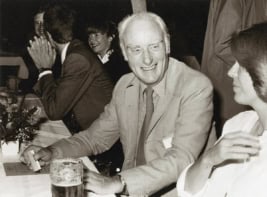Collaboration, engagement, outreach – the modern physicist is continually encouraged to keep talking and communicating. Felicity Mellor wonders if it would be better if we simply stayed silent

Isaac Newton craved it. So did Albert Einstein. Henry Cavendish and Paul Dirac positively exuded it. Silence, and its companion solitude, seems to be a recurring feature in the history of physics. Yet current research policy, in the UK at least, emphasizes silence’s opposite. From assessing publications and rewarding collaborations, to requirements for public engagement, policy initiatives urge scientists to speak up. There is a danger that in the midst of all this enforced interaction, an important precondition for creativity in physics could be lost. With all these demands to talk, do scientists still have the chance to think?
The ideal of the solitary scholar has a long history in Western society. For all the rhetoric of openness and public demonstration that accompanied the establishment of the Royal Society in the 17th century, natural philosophy also continued to draw on the tradition of the isolated intellectual that had characterized much religious thought. Newton, in particular, cultivated the image of the hermit – dishevelled, shut away in his rooms, thinking about esoteric matters that few others could hope to understand. He published reluctantly, attempting to restrict his audience to only those he thought capable of appreciating his work. Indeed, it was only after much persuasion that he eventually agreed to his Principia being published in full.
A century later, Henry Cavendish was similarly reluctant to publish, with most of his research remaining hidden in his notebooks for decades after his death. Cavendish not only worked in isolation but was also famous for his silence when in company, refusing to speak even to his servants and communicating instead by notes. That did not, however, stop him making great advances in everything from the nature of gravity and electrical forces to thermodynamics and the chemistry of gases.
In the modern era, too, it is not difficult to find physicists whose working style was characterized by silence. Einstein spoke of never having lost “a need for solitude”, while Dirac’s colleagues joked that his name should be given to a unit for the fewest words it was possible to utter while in company, a measure that they put at one word per hour.
The recurring silences of physics tell us that, for many physicists, intellectual progress requires control over the communication networks of which they are a part
Of course, not all physicists are silent types. Niels Bohr, for instance, has been characterized in one biography by historian Robert P Crease and journalist Charles Mann as “The man who talked”. If Einstein preferred “to think in apartness”, as his biographer Abraham Pais put it, Bohr preferred to think through speech, developing his ideas by talking with others so that even the process of finding the right words became something to be pondered out loud. Yet Bohr’s interlocutors also needed time away from all that talk. Werner Heisenberg retreated to the tiny island of Heligoland to escape from hay fever, and it was only then, reflecting on recent discussions with Bohr but not immersed in them, that he laid down the basis of his formulation of quantum mechanics. He was again away from Bohr when he wrote his uncertainty paper.
As Heisenberg’s example suggests, formative silences rarely, if ever, consist of absolute withdrawal. Historians of science have repeatedly shown that even those breakthroughs that seem to come from nowhere emerge from shared learning, external stimulation and networks of support. Even Newton, for all his curmudgeonly ways, corresponded with other natural philosophers, and Cavendish’s excessive shyness did not prevent him from regularly attending scientific meetings. Despite their reclusive tendencies, both men also contributed to public affairs – Newton at the Royal Mint and Cavendish as an active committee member at the Royal Society and the British Museum. The myth of the lone genius has little basis in fact.
Controlling one’s communication
Rather than being mutually incompatible, silence and communication form a delicate balance. As historian Mara Beller has said of Heisenberg’s need to get away from Bohr, Heisenberg was striving not for intellectual isolation but to regain the “proper, uncoerced balance” in his communications. The recurring silences of physics tell us not that individual genius is the sole source of creativity, but that, for many physicists, intellectual progress requires control over the communication networks of which they are a part. Communication, yes, but on the physicist’s own terms, in the manner that suits each individual best.
So how much control do scientists today have over their level of communication? Not much, by some accounts. Peter Higgs has recently claimed that he would not have been able to complete his Nobel-prize-winning work in the current research environment. The peace and quiet that he enjoyed in the 1960s is, he thinks, no longer a possibility.
One example of this shift from a balance between silence and communication to a near-exclusive focus on the latter can be found in the ways in which institutes of advanced study have been conceived. Writing in 1931, Abraham Flexner, founding director of the Institute of Advanced Study in Princeton, envisioned his institute as a place that “should be simple, comfortable, quiet without being monastic or remote”. It would provide “the tranquillity and the time requisite to fundamental inquiry into the unknown”. Located in extensive grounds close to, yet entirely separate from, the university, Flexner’s institute facilitated collaboration within a context of retreat.
The most successful physicists have been able to strike a balance between coming forth and holding back
By contrast, the new generation of advanced study institutes that have appeared in the UK over the last decade sit within universities and emphasize collaboration and social impact over withdrawal and speculative contemplation. Durham University’s Institute of Advanced Study, for instance, aims at “bringing together some of the world’s finest researchers from all disciplines” to work with the university’s own staff. It also “serves as a top-level forum, enabling key decision makers and experts to discuss pressing policy problems”. Likewise, the University of Warwick’s Institute of Advanced Study aims to “promote collaborative research projects”, especially through “international engagement” and “links with the university’s strategic partners”.
These are laudable aims, but it is striking that the need for periods of withdrawal and solitude are no longer acknowledged as a means of facilitating intellectual advances. History shows us that the most successful physicists have been able to strike a balance between coming forth and holding back, between public discussion and private contemplation. Yet reticence and silence seem to have no place in the modern research agenda. Delete the silences from speech, and one is left with incoherent babble. Delete the silences from scientific research and perhaps the result will be nothing but noise.



